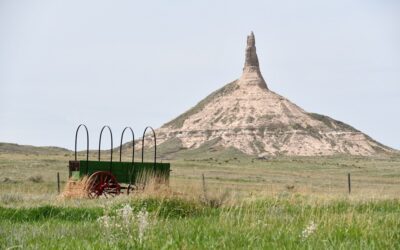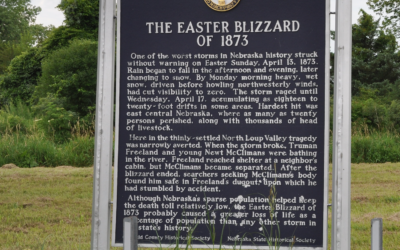We get a variety of objects that come in to the Ford Center for treatment. Most are from private clients, others come from museums and libraries, and some are from the Nebraska State Historical Society Collection. Sometimes the objects we work are historically significant, like Harry Truman’s belongings from World War I or the last document Abraham Lincoln signed before he died, but the treatments are relatively straightforward. Other times, the objects themselves aren’t historically significant, but the treatment is fascinating. The object may look hopeless when it arrives and we’re able to not only stabilize it, but return it closer to its original appearance. And every so often, we get a project that is both historically significant and requires an interesting treatment.
The Painting
One such project was the painting, “Peter and Pavel” by Paul Powis which belongs to the Nebraska State Historical Society. It has a literary significance as it is believed to have been an inspiration for Willa Cather. The painting depicts two men in a shed being chased by wolves. This painting may have inspired Cather when she wrote the memorable scene of the wolves chasing the bridal party in My Antonia.
The image on the left shows the painting before treatment. The image detail on the right shows how the horses heads are misaligned and that the tears have been filled.
The Problem
The curator brought the painting to our Paintings Conservator, Kenneth Bé to stabilize and repair two large gashes in the canvas. There was no record as to what had happened to the painting to cause this damage, but he knew it had been treated sometime in the past as it had been lined onto a new canvas backing. When the canvas had been lined, the person who did it had not realigned the tears in the painting, and gaps were still visible. Not only that, because the painting had been put on a new stretcher, if the old tears were to be realigned to fix the image, it would create distortions in the rest of the canvas. The painting now how two problems: the tears themselves and their misalignment with the previous repair. How could the visual distraction of the tears be minimized without creating new distortions in the painting and possibly causing new tears to form from the strain? Kenneth had two choices: remove the painting from the old backing and line up the tears, but risk distorting the image and causing new tears. Or he could remove the painting from the old backing and leave the tears as they were and instead visually repair the tears.
The Solution
The conservator decided the best option was to visually repair the tears without attempting to physically narrow or close them. The gaps were instead filled with white gesso material, similar to a spackle fill. These fills would be inpainted to visually harmonize with the current state of the painting’s appearance. The lower tear was mostly located across the foreground on snowy terrain in the painting; it would be straightforward to inpaint to minimize the hide the fact that the image was misaligned. However, the upper tear was right over the horses’ heads! If the losses were filled to match the tops of the horses’ heads to their noses, the horses would look disfigured with too much vertical offset and retouching would grossly elongate their heads. Therefore, Kenneth decided the only thing to be done was to copy the horses’ heads within the gaps and then cover over the original paint of the top of the horses’ heads to match the background. (See the photos below) While it is not uncommon for a conservator to fill in losses and in-paint missing areas, it is very unusual for a conservator to paint over original parts of a work of art. However, this time it was in the best interest of the painting, both to ensure its stability and bring it closer to the artist’ intended appearance. And, following the American Institute of Conservation’s Code of Ethics, the process was documented with before and after treatment photography and the treatment carried out is reversible so it can be undone in the future if the need ever arises. Now, as exhibited, the view can see the painting without the distraction of the offset tear and the painting can be seen more like the way Willa Cather once saw it.
After being filled, the filled areas within the tear were inpainted to look like the image immediately above.
Finally, the barrier layers were covered and inpainted to blend in with the surrounding image.
The parts of the image that had been copied were then coved with a barrier layer. The barrier layer is so that should the treatment need to be reversed in the future, it can be easily removed without disturbing the original paint.



